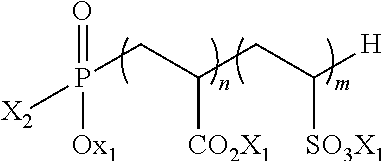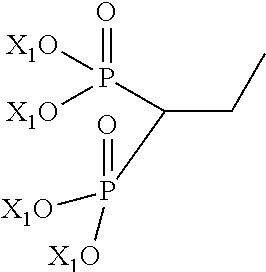Detergent compositions comprising vinylidene diphosphonic acid polymers
a technology of diphosphonic acid and detergent composition, which is applied in the direction of organic detergent compounding agents, cleaning using liquids, non-ionic surface active compounds, etc., can solve the problems of heavy soil accumulation on hard surfaces, and achieve the effect of preventing soil accumulation and improving control of hard water scal
- Summary
- Abstract
- Description
- Claims
- Application Information
AI Technical Summary
Benefits of technology
Problems solved by technology
Method used
Image
Examples
example 1
[0122]Hard water film accumulation testing was conducted using a light box evaluation of 100 cycle glasses. The 100 cycle experiment was performed using six 10 oz. Libby glasses on a Hobart AM-15 ware wash machine employing 17 grain water (hard water source). Initially the glasses were prepared using a cleaning cycle to completely remove all film and foreign material from the glass surface.
[0123]The Example compositions shown in Table 1 were evaluated. The controls employed were a commercially-available alkali metal detergent composition (Solid Power XL, available from Ecolab, Inc.) (Control 1) and a Negative Control (shown below in Table 1).
[0124]
TABLE 1NegativeRaw materialControlEx 1Ex 2Ex 3Water25411.511.5Sodium hydroxide (beads)75666666Vinylidene diphosphonic acid 0301515polymerThreshold Agent Polymer -007.50Bayhibit AM (50%)Threshold Agent Polymer -0007.5Belclene 200 (50%)
[0125]The vinylidene diphosphonic acid polymer and threshold agents employed are commercially available fro...
example 2
[0136]The cleaning efficacy of the detergent compositions according to the invention and controls (described above in Table 1) were further evaluated using a 50 cycle antiredeposition experiment for institutional ware wash detergents. To test the ability of compositions to clean glass and plastic, 6 10 oz. Libby heat resistant glass tumblers and 1 plastic tumblers were used. The glass tumblers were cleaned prior to use. New plastic tumblers were used for each experiment.
[0137]A food soil solution was prepared using a 50 / 50 combination of beef stew and hot point soil and employed at 2000 ppm soil. The soil included two cans of Dinty Moore Beef Stew (1360 grams), one large can of tomato sauce (822 grams), 15.5 sticks of Blue Bonnet Margarine (1746 grams) and powered milk (436.4 grams). The hot point soil was added to the machine to maintain a sump concentration of about 2000 ppm.
[0138]After filling the dishmachine with 17 grain water, the heaters were turned on. The wash temperature w...
PUM
| Property | Measurement | Unit |
|---|---|---|
| temperature | aaaaa | aaaaa |
| mass | aaaaa | aaaaa |
| mass | aaaaa | aaaaa |
Abstract
Description
Claims
Application Information
 Login to View More
Login to View More - R&D
- Intellectual Property
- Life Sciences
- Materials
- Tech Scout
- Unparalleled Data Quality
- Higher Quality Content
- 60% Fewer Hallucinations
Browse by: Latest US Patents, China's latest patents, Technical Efficacy Thesaurus, Application Domain, Technology Topic, Popular Technical Reports.
© 2025 PatSnap. All rights reserved.Legal|Privacy policy|Modern Slavery Act Transparency Statement|Sitemap|About US| Contact US: help@patsnap.com



